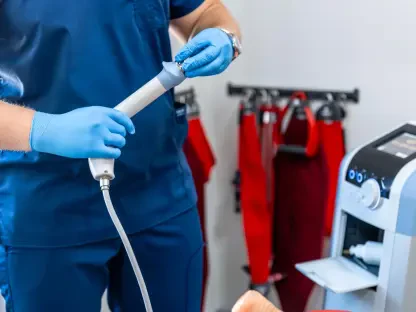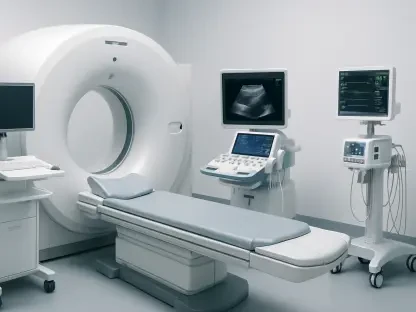In the sprawling healthcare landscape of Northeast Tennessee and Southwest Virginia, Ballad Health, a 21-hospital system spanning 29 counties, has faced daunting challenges like workforce shortages, escalating costs, and persistent risks to patient safety. Amid these pressures, an innovative solution has emerged through the integration of robotic automation in pharmacy operations, fundamentally transforming how medications are managed and distributed across the network. This isn’t merely a technological upgrade but a strategic overhaul that addresses inefficiencies head-on, using tools like the Omnicell XR2 robot to power a central fill pharmacy model. The impact is profound, reshaping workflows, enhancing care quality, and even restoring services to underserved communities. This exploration delves into the mechanisms behind this transformation, uncovering how automation tackles systemic issues, optimizes limited resources, and sets a benchmark for other health systems navigating similar struggles. The journey of Ballad Health offers a compelling glimpse into the future of healthcare efficiency.
Revolutionizing Operations Through Centralization
Ballad Health’s initial pharmacy structure was a patchwork of independent operations at each of its 21 hospitals, a setup that bred inefficiencies and inconsistencies across the board. Staff at each location managed separate inventories, often resulting in medications expiring unused at one facility while being urgently needed at another. The manual nature of these processes consumed countless hours, stretching an already overworked workforce thin, particularly as staffing shortages intensified in recent years. The risk of human error in dispensing loomed large, threatening patient safety. Recognizing the unsustainability of this fragmented approach, the health system turned to a centralized model, consolidating operations into a single hub powered by robotic automation. This shift, supported by advanced technology like the Omnicell XR2, marked a turning point, enabling streamlined medication dispensing and distribution while significantly cutting down on redundant tasks and operational overheads that once plagued the system.
The central fill pharmacy hub operates with remarkable precision, thanks to robotic systems affectionately dubbed Dolly, Johnny, and June, which handle the picking, packaging, and verification of medications for the entire network. What previously demanded over 240 technician hours daily at each site is now managed by just 17 full-time equivalents across all hospitals. These robots integrate seamlessly with automated dispensing cabinets and electronic health records at each location, ensuring that orders are processed without hiccups. Barcode scanning at every stage of the process has virtually eliminated medication errors, a critical advancement in a field where accuracy is non-negotiable. Beyond just reducing labor, this centralization has slashed costs and freed up valuable time, allowing the focus to shift from repetitive manual tasks to more impactful areas of healthcare delivery. The result is a system that operates with newfound agility, proving that technology can be a powerful ally in overcoming long-standing operational bottlenecks.
Optimizing Staff Roles for Enhanced Care
One of the most pressing challenges for Ballad Health was the persistent difficulty in recruiting and retaining pharmacy staff, a problem that grew more acute in the wake of widespread labor shortages. Rather than replacing human workers, robotic automation has redefined their roles, turning a potential crisis into an opportunity for improvement. By taking over repetitive tasks such as medication dispensing and packaging, the technology has allowed pharmacists and technicians to be redeployed to higher-value clinical activities. This means more time spent on patient education, medication reconciliation, and direct care interactions—areas where professional expertise can make a tangible difference in outcomes. This strategic shift not only addresses staffing gaps but also elevates the quality of service provided, ensuring that patients receive more personalized attention from skilled professionals who are no longer bogged down by routine duties.
The impact on workforce dynamics extends beyond just role reallocation; it has fundamentally eased the strain on overworked teams. With fewer staff required to handle manual dispensing across multiple sites, the central hub model has created a more sustainable staffing structure, reducing burnout and improving job satisfaction. Pharmacists, in particular, can now practice at the top of their licenses, focusing on complex clinical reviews and patient discharge counseling that directly contribute to better health results. This approach demonstrates a critical insight: technology, when thoughtfully implemented, serves as a support mechanism for human resources rather than a threat to employment. Ballad Health’s experience highlights how automation can align with broader healthcare goals, ensuring that limited personnel are utilized where their skills have the greatest impact, ultimately benefiting both staff and the patients they serve.
Elevating Patient Safety and Inventory Control
Patient safety stands as a cornerstone of Ballad Health’s transformation, with robotic automation delivering a near-elimination of medication errors that have long been a concern in hospital settings nationwide. The central fill model ensures that every dose undergoes rigorous verification through automated barcode scanning before reaching a patient, addressing a major source of risk in traditional pharmacy workflows. This meticulous process aligns with the healthcare industry’s urgent push to prioritize outcomes through technological innovation, positioning Ballad Health as a frontrunner in safeguarding patient well-being. The precision of these systems not only minimizes mistakes but also builds trust in the reliability of medication delivery, a vital component of effective care. By leveraging such advancements, the health system has set a high standard for accuracy, demonstrating how automation can directly translate into life-saving improvements across diverse hospital environments.
Equally significant are the gains in inventory management, which have proven to be a financial and operational boon for Ballad Health. The earlier decentralized approach often resulted in stockouts, expired medications, and wasted resources, leading to treatment delays and unnecessary costs. Centralizing inventory control at the hub has reduced waste by an impressive 64%, thanks to data-driven tracking of usage patterns that ensure drugs are stocked based on actual need. This means critical therapies are readily available where required, preventing disruptions in patient care while enhancing formulary compliance across all facilities. The cost savings from minimizing expired drugs and optimizing stock levels are substantial, especially in an era of rising pharmacy expenses and persistent drug shortages. This efficient approach to resource management offers a replicable model for other systems grappling with similar supply chain challenges, underscoring the multifaceted benefits of a technology-driven pharmacy framework.
Extending Care Access to Rural Communities
A particularly inspiring outcome of Ballad Health’s pharmacy overhaul is the tangible impact on underserved areas, most notably through the reopening of Lee County Community Hospital. This rural facility, closed for nearly a decade, became financially viable to operate again under the central fill model, which eliminated the need for standalone staffing and inventory costs at the site. For a community that once faced travel times of over an hour to access emergency and inpatient care, this restoration of services represents a lifeline. The ability to provide essential medical support closer to home not only improves health outcomes but also alleviates the burden on residents who previously endured significant hardship to seek treatment. This achievement illustrates how operational efficiencies gained through robotics can extend far beyond hospital walls, directly addressing disparities in healthcare access that disproportionately affect rural populations.
The broader implications of this initiative resonate deeply within the context of ongoing challenges in rural healthcare across the United States. By demonstrating that technology-driven models can make pharmacy operations sustainable in smaller, remote facilities, Ballad Health has highlighted a potential pathway to bridge critical gaps in service delivery. The central hub’s ability to support multiple hospitals, including those in isolated areas, ensures that resources are allocated efficiently without compromising care quality. This ripple effect suggests that similar innovations could empower other health systems to revive shuttered facilities or expand services in neglected regions, tackling systemic inequities. The success in Lee County serves as a powerful reminder that the benefits of automation are not confined to metrics of efficiency or cost but can profoundly enhance the lives of communities long deprived of adequate medical infrastructure, setting a precedent for meaningful change.
Reflecting on a Path Forward with Technology
Looking back, Ballad Health’s adoption of robotic automation and a centralized pharmacy model marked a pivotal moment in addressing entrenched issues of inefficiency, safety risks, and staffing constraints. The journey saw dramatic reductions in medication errors, a 64% drop in inventory waste, and a reallocation of staff to clinical roles that uplifted patient care standards. The reopening of a rural hospital underscored the far-reaching potential of these changes, proving that innovation could restore vital services to communities in need. As other health systems consider similar transformations, the emphasis should remain on framing automation as a tool for safety and quality, not merely savings. Thoughtful change management, data-driven inventory strategies, and clear communication with stakeholders stand as essential steps to replicate such success. Moving forward, the focus must be on scaling these models, refining integration with evolving technologies, and ensuring that the human element of care remains at the heart of technological progress.









